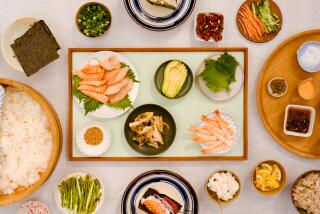For tender squid, easy does it
- Share via
THANKS to the popularity of fried calamari, almost everyone has eaten squid, even if very few people have cooked it. Really, there’s not that much to it.
The most important thing you have to know is that squid is almost pure muscle, with little fat. That means it cooks very quickly and overcooks almost as fast. If you’ve ever had calamari with the texture of rubber bands, it was because someone wasn’t paying attention and let it cook a minute or two too long.
On the other hand, cook squid long enough and it will once again soften, this time to a marvelous silky texture as compared with its toothsome firmness when quickly blanched.
You’ll hear slight variations on this, but as a general rule, cook squid for less than a minute or more than 20 minutes.
The main exception to this rule is when you’re deep-frying. In this case, because it’s coated with a protective layer of flour before cooking, it can go a little longer than when blanched or sauteed. But not too much -- maybe two or three minutes, tops.
Making fried calamari couldn’t be easier (probably a big part of the reason it’s on so many bar menus). At its simplest, you just dredge the squid rings in seasoned flour and dump them in hot oil.
There are twists and refinements, of course. One of the very best fritto misto plates I’ve ever had was a squid-heavy one at Esca, Mario Batali’s Manhattan seafood restaurant. Chef David Pasternack uses a combination of Wondra “instant” flour and cornstarch to get a thin, crackling crust.
He also uses a lower temperature than most -- 275 degrees. Pasternack says this helps keep the squid moist while the crust gets crisp.
If you go to the Monterey area, the original home of the California squid fishery, it’s common to find squid served in salads. These are just as simple to make as fried squid and offer almost unlimited opportunities for improvisation.
Essentially, a squid salad begins by blanching the tubes and tentacles very quickly in boiling water, then marinating them briefly in a vinaigrette. After that, you can do what you like: Serve it by itself as part of an antipasto platter or pair it with crunchy vegetables like celery or fennel.
You can flavor the dressing however you want, though squid has a particular affinity for garlic and lemon juice. Start there and you can’t go far wrong.
And you can even mess around with how you cut the squid. It’s easiest just to cut it in rings, but it’s very pretty to slit the tube open to form a single sheet, cut it in wide pieces and then lightly score those with a sharp knife. This way, when you blanch it, the squid twists and curls like some exotic pasta shape.
Perfect for stuffing
ALTHOUGH squid is almost always cooked quickly, it may surprise you how good squid can be when it is braised for a relatively long time (30 to 40 minutes, say, for most dishes, but still under an hour). You can do this simply in a tomato or white wine sauce, or make it a little more complicated by stuffing the squid first.
Indeed, with its sock-like shape, squid practically begs to be stuffed. The mixture can be as simple as chopped tentacles and bread crumbs. Or it can be something more savory, such as Italian sausage.
For sausage-stuffed squid, stuff, then sear the squid. After it puffs up and colors, simmer it in a slightly spicy, caper-spiked tomato sauce until tender. For the last 15 minutes, add steamed potatoes to soak up some of the liquid and you’ve got a full meal.
However you’re going to prepare it, the first step in cooking squid is cleaning it. And even though it seems a little involved and messy, it’s really not as bad as cleaning any other fish. (You can get squid already cleaned at some fancy groceries, but it comes at a premium and is usually imported from Thailand.)
Begin by separating the tentacles from the tube. Pull them apart gently but firmly, and most of the squid’s innards will come out attached to the legs. Cut off the tentacles just below the eyes and pluck out the hard beak that is hidden in the center and discard it.
Feel along the outside of the tube and you’ll find the hard quill, the only “bone” in the squid. It will protrude slightly from the tube at the opening in a kind of widow’s peak. Grab it firmly and pull and it will come out neatly.
Lay the tube end on the cutting board and using the back of a knife, press gently but firmly from the point to the opening -- as if you’re squeezing the last bit of toothpaste out of a tube. You’ll probably get a blob of white fatty stuff, which you should discard.
Rinse the tube inside and out. If you prefer, you can use your fingers to pull away the purple membrane on the outside of the tube, but if you leave it on, parts of the thin peel will turn a brilliant purple when cooked that is really pretty.



